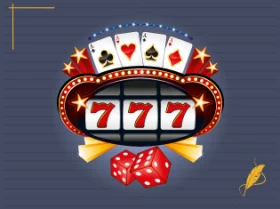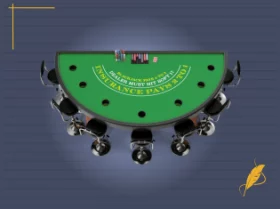As players seek the upper hand, they turn to card counting — a method shrouded in secrecy for many decades. It’s a skill that requires a sharp mind and a keen eye for detail. Players harness their knowledge of the deck’s composition, tracking the ever-shifting balance between high-value and low-value cards and adjusting their stakes accordingly.
But the question remains: How do casinos know you’re counting cards? This article takes you through the world of card counting, so you can know about the classic tricks players may use while gambling and all the important details around this topic.
Understanding the Science of Counting Cards
Card counting is a technique players use to gain an advantage, particularly in casino table games like blackjack. Contrary to popular belief, it doesn’t require memorising every single card. Instead, it involves maintaining a rough count of high and low-value cards in the deck. Every card in the deck is assigned a value with +1 for low-value cards and -1 for high-value cards.
An increasing count indicates that more high-value cards remain in the deck, meaning the player has a better chance of getting a Blackjack (an Ace and a 10-value card). Contrarily, when the count is low, it suggests that more low-value cards are left, which is less favourable for the player.
Players who count cards adjust their stakes based on the current count. When the count is in their favour, they might place big bets; when not, they play minimum bet or simply make a flat bet conservatively. Successful counting requires skill, practice, and a good understanding of the game. As such, it’s not a guaranteed way to win, as it involves an element of chance and risk.
Is Cards Counting Really Against the Law?
Card counting in casinos is not illegal; however, you may be refused service if found doing this. Moreover, this technique can be also used in online poker games like Seven Card Stud Poker. On the other hand, using devices to assist in card counting or working with other players may be considered illegal. If casinos catch card counters, they may be asked to leave the casino premises.
Some even share information about suspected card counters with other establishments. Counting cards doesn’t guarantee your chances of winning. It just provides a statistical advantage over the casino but does not eliminate the element of chance. Casinos have the right to take action against players using legal card-counting techniques to protect their interests.
Unveiling the Secret: How Casinos Know Spot Card Counters?
Land-based establishments actively discourage players who count cards. They use various methods and surveillance techniques to identify players who are counting. Below we have listed the common ways casinos may spot cheating players.
Betting Patterns
Card counters typically adjust their bets based on the count. They consistently raise bets when the count is favourable or place a double down bet in blackjack and reduce them when it’s not. This distinctive betting pattern is a telltale sign of someone counting.
Unusual Behavior
In addition to betting patterns, casino staff looks for unusual player behaviour. Some card-counting teams use signals or other communication methods to share information. For example, card counters make covert gestures to their teammates, such as touching their faces or scratching their ears, to communicate without being detected.
Time and Money
Players who count cards spend longer at the table and engage in many hands. The longer the game, the higher their chances of winning because their advantage increases with the number of hands played. Casinos, however, keep a close eye on the duration of play and the bets placed. If these factors remain remarkably consistent, it can raise suspicion.
Consistent Winnings
If a player consistently wins over a long period, especially in games with a considerable house edge like a blackjack table, chances are that they count cards. So, the casino may intervene to check if the player is using counting or any other strategy like the Martingale system that gives them an unfair advantage.
Pit Bosses
Casino personnel, particularly pit bosses, are trained to watch for signs of card counting. For example, they may observe blackjack players who vary their stakes significantly based on the card count or deviate from the basic blackjack strategy that suggests they are counting cards.
Players Database
Most casinos maintain a database of players. They employ player-tracking systems to record bet patterns, wins, losses, and other behaviours, including play style. If a player consistently counts cards or uses any unfair means to gain an advantage, this information can be used to identify them.
A Skillful Strategy or Risky Business?
Knowing how to count cards is a skill that requires a good understanding of the game, the ability to perform mental calculations quickly and accurately and, above all, practice. Not many can become a professional gambler by card counting alone. It may not be a suitable strategy if you’re not confident in your ability to count cards effectively. Furthermore, it is not a guaranteed way to win money. There‘s always an element of chance.
While counting can give you an edge over the casino, it’s not for the faint of heart. Successful counting requires a high degree of skill and practice. Even if done correctly, it is not a guaranteed way to win, and casinos actively discourage it. If caught, you may be either blacklisted or banned.
Guarding the House Edge: Preventing Card Counting
Casinos employ several tactics and strategies to limit the effectiveness of counting cards. While this trick is not illegal, it is well within the rights of the casinos to maintain their advantage. Here are some standard methods used to limit counting:
- Multiple Decks: Casino dealers use multiple decks of playing cards, often six to eight. It makes it difficult for players to count the cards in play accurately.
- Shuffling Machines: Continuous shuffling machines have become increasingly prevalent. They continuously shuffle the cards after each hand, making it impossible for players to track the deck’s composition.
- Cut Card Placement: A cut card is often placed as a signal for casino dealers to shuffle the cards using automatic shuffling machines. Placing the cut card closer to the front of the deck is a strategy to make counting the cards less effective.
- Increased Vigilance: Casinos in Australia invest heavily in advanced surveillance systems, including security cameras. They also train their staff to detect suspicious behaviour. This makes it challenging for card counters to go unnoticed.







![The Richest Gamblers in the World [TOP 15]](https://www.slotozilla.com/au/wp-content/uploads/sites/35760/new_uploads/2024/02/blog-sz-au-1-280x209.webp)


